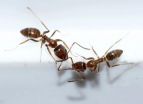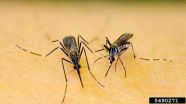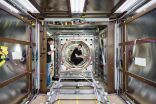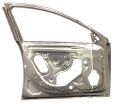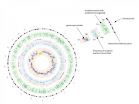Prenatal exercise lowers risks of C-sections, higher birth weights
2015-05-12
Pregnant women who exercise can significantly lower the risk of undergoing Caesarean sections and giving birth to large babies, a University of Alberta study has found.
Prenatal exercise has been suggested to be a means to prevent childhood obesity through a "normalization" in birth weight (ie. reducing the risk of having a large baby at birth). University of Alberta researchers conducted a meta-analysis to analyze 28 randomized control studies encompassing 5,322 women that looked at the influence of maternal exercise on baby outcomes.
"We found that women who exercised ...
How the presence of conservation researchers affects wildlife
2015-05-12
In a study that compared three sites within the Dja Conservation Complex in Cameroon, Africa, investigators found that the presence of a conservation research project acts as a deterrent to chimpanzee and gorilla poachers, and community awareness and involvement in research lead to an increased value of apes and intact forests to local people, thus limiting hunting practices.
The results provide evidence that the mere existence of research programs exerts a positive impact on the conservation of wildlife in their natural habitats.
"It's important to recognize the effectiveness ...
Psychotic hallucinations, delusions rarely precede violence
2015-05-12
Mass shootings at the hands of unhinged loners - such as those in Aurora, Colorado; Santa Barbara, California, and Newtown, Connecticut - perpetuate a commonly held belief that mental illness triggers violent crimes.
But a new study from the University of California, Berkeley, shows that hallucinations and delusions associated with psychiatric disorders seldom foreshadow acts of aggression.
In a painstaking review of 305 violent incidents in the United States, the researchers found that only 12 percent were preceded by psychosis. While numerous studies have found that ...
Ants' movements hide mathematical patterns
2015-05-12
When ants go exploring in search of food they end up choosing collective routes that fit statistical distributions of probability. This has been demonstrated by a team of mathematicians after analysing the trails of a species of Argentine ant. Studies like this could be applied to coordinate the movement of micro-robots in cleaning contaminated areas for example.
Scientists have yet to discover the mechanisms explaining how flocks of birds, shoals of fish, lines of ants and other complex natural systems organise themselves so well when moving collectively.
To tackle ...
New device provides chikungunya test results in an hour
2015-05-12
Scientists at a U.S. Army research center have modified an assay that tests whether or not a sample of mosquitoes harbors the virus responsible for the disease known as chikungunya (CHIKV), long a problem in the Old World tropics but recently established in the Americas. Their assay is described in an article in the Journal of Medical Entomology.
Health workers now have a quick way to detect the presence of the CHIKV virus within an hour, rather than waiting for results of laboratory tests that take days, or even weeks. It's done with a chemical dipstick, the same kind ...
Bacteria the newest tool in detecting environmental damage
2015-05-12
KNOXVILLE--The reaction most people have when they hear the word bacteria is rarely a good one.
While it's true that food- and water-borne bacteria cause untold illnesses and even death around the world, a team of researchers from the University of Tennessee, Knoxville, and Oak Ridge National Laboratory has found a way to use bacteria to help prevent some of the very symptoms most people associate with them.
Terry Hazen, the Governor's Chair for Environmental Biotechnology, a joint UT-ORNL appointment, is working with a team of researchers who have developed a method ...
Survival from rare bone cancer remains low
2015-05-12
MAYWOOD, IL - Among the deadliest cancers is a rare malignancy called mesenchymal chondrosarcoma, which begins in cartilage around bones and typically strikes young adults.
Ten-year survival has been reported to be as low as 20 percent. But a Loyola University Medical Center study has found survival is not as dismal as prior reports. Among 205 cases examined, more than half (51 percent) of patients survived at least five years, and 43 percent survived at least 10 years, the study found.
The study by senior author Lukas Nystrom, MD, and colleagues was reported at the Mid-America ...
Rethinking the rebound: Unexpected effects of rejection
2015-05-12
May 12, 2015 - It's portrayed in movies again and again - a character gets rejected by someone attractive and then falls willingly into the arms of someone perhaps less attractive. According to a new study, it's not so simple: Rejection by an attractive man actually led women to socially distance themselves from an unattractive man, even when he offered acceptance.
"We hadn't expected to see derogation of the unattractive male when women had been rejected by the attractive male," says Geoff MacDonald of the University of Toronto and lead author of the new study in Social ...
Cause of regression in individuals with down syndrome identified
2015-05-12
COLUMBIA, Mo. - Down syndrome, the most common chromosomal disorder in America, can be complicated by significant deterioration in movement, speech and functioning in some adolescents and young adults. Physicians previously attributed this regression to depression or early-onset Alzheimer's, and it has not responded to treatments. Now, a researcher at the University of Missouri has found that Catatonia, a treatable disorder, may cause regression in patients with Down syndrome. Individuals with regressive Down syndrome who were treated for Catatonia showed improvement, the ...
The weakest magnetic field in the solar system
2015-05-12
This news release is available in German.
Magnetic fields easily penetrate matter. Creating a space practically devoid of magnetic fields thus presents a great challenge. An international team of physicists has now developed a shielding that dampens low frequency magnetic fields more than a million-fold. Using this mechanism, they have created a space that boasts the weakest magnetic field of our solar system. The physicists now intend to carry out precision experiments there.
Magnetic fields exist everywhere in the universe. Here on the Earth, we are permanently ...
Out with heavy metal
2015-05-12
RICHLAND, Wash - Researchers have demonstrated a new process for the expanded use of lightweight aluminum in cars and trucks at the speed, scale, quality and consistency required by the auto industry. The process reduces production time and costs while yielding strong and lightweight parts, for example delivering a car door that is 62 percent lighter and 25 percent cheaper than that produced with today's manufacturing methods.
In partnership with General Motors, Alcoa and TWB Company LLC, researchers from the Department of Energy's Pacific Northwest National Laboratory ...
Children exposed to multiple languages may be better natural communicators
2015-05-12
Young children who hear more than one language spoken at home become better communicators, a new study from University of Chicago psychologists finds. Effective communication requires the ability to take others' perspectives. Researchers discovered that children from multilingual environments are better at interpreting a speaker's meaning than children who are exposed only to their native tongue. The most novel finding is that the children do not even have to be bilingual themselves; it is the exposure to more than one language that is the key for building effective social ...
New research will help forecast bad ozone days over the western US
2015-05-12
New research published in Nature Communications led by Meiyun Lin of NOAA's Geophysical Fluid Dynamics Laboratory and NOAA's cooperative institute at Princeton University, reveals a strong connection between high ozone days in the western U.S. during late spring and La Niña, an ocean-atmosphere phenomena that affects global weather patterns.
Recognizing this link offers an opportunity to forecast ozone several months in advance, which could improve public education to reduce health effects. It would also help western U.S. air quality managers prepare to track these ...
Political talk on Facebook mirrors political talk offline
2015-05-12
LAWRENCE -- Political discussions conducted on social networking sites like Facebook mirror traditional offline discussions and don't provide a window into previously untapped participants in the political process, according to a new study that includes two University of Kansas researchers.
"Social networking is important, but what we've shown in political science is that the people who are using the Internet, be it Facebook, Twitter or whatever else for political activities, are really the same people who are politically active offline anyway," said Patrick Miller, a ...
CU Anschutz researchers create microscope allowing deep brain exploration
2015-05-12
AURORA, Colo. (May 12, 2015) - A team of neuroscientists and bioengineers at the University of Colorado Anschutz Medical Campus have created a miniature, fiber-optic microscope designed to peer deeply inside a living brain.
The researchers, including scientists from the University of Colorado Boulder, published details of their revolutionary microscope in the latest issue of Optics Letters journal.
"Microscopes today penetrate only about one millimeter into the brain but almost everything we want to see is deeper than that," said Prof. Diego Restrepo, PhD, one of the ...
Family genetics study reveals new clues to autism risk
2015-05-12
A study of 2,377 children with autism, their parents and siblings has revealed novel insights into the genetics of the condition.
The findings were reported May 11 in Nature Genetics.
By analyzing data from families with one child with autism and one or more children without the condition, the researchers collected new information on how different types of mutations affect autism risk. The genetic data was obtained from exome sequencing, which looks at only the protein-coding portions of the genome.
Significant progress in the past five years has been made in ...
Aclidinium bromide/formoterol in COPD: Added benefit for certain patient groups
2015-05-12
The fixed-dose combination aclidinium bromide/formoterol has been approved since November 2014 for long-term treatment of adults with chronic obstructive pulmonary disease (COPD). The German Institute for Quality and Efficiency in Health Care (IQWiG) examined in a dossier assessment whether this drug combination offers an added benefit over the appropriate comparator therapy.
According to the findings, there is an indication of minor added benefit for adult patients with moderate COPD (grade II). For adults with grade III and fewer than 2 exacerbations (flare-ups) per ...
Gender difference in vital cell count of HIV patients
2015-05-12
Male HIV patients in rural South Africa reach the low immunity levels required to become eligible for antiretroviral treatment in less than half the time it takes for immunity levels to drop to similar levels in women, according to new research from the University of Southampton.
Researchers also found a link between potential proxy measures of nutritional status and disease progression, with those reporting food shortages and use of nutritional supplements reaching lower levels of immunity faster.
CD4 cell count is a measure of the immune system which indicates the ...
Quantum 'gruyères' for spintronics of the future
2015-05-12
They are 'strange' materials, insulators on the inside and conductors on the surface. They also have properties that make them excellent candidates for the development of spintronics ('spin-based electronics') and more in general quantum computing. However, they are also elusive as their properties are extremely difficult to observe. Now a SISSA study, published in Physical Review Letters, proposes a new family of materials whose topological state can be directly observed experimentally, thus simplifying things for researchers.
"What interests us of topological insulators ...
A gap year does not weaken study success
2015-05-12
A gap year between high school and the start of university studies does not weaken young people's enthusiasm to study or their overall performance once the studies have commenced. On the other hand, adolescents who continue to university studies directly after upper secondary school are more resilient in their studies and more committed to the study goals. However, young people who transfer directly to university are more stressed than those who start their studies after a gap year. These research results have been achieved in the Academy of Finland's research programme ...
Malaria testing yet to reach its potential
2015-05-12
In a study published this month in Malaria Journal, researchers from Uppsala University and other institutions present a new model for systematically evaluating new malaria treatment programs in routine conditions across multiple countries.
Despite major investments in malaria rapid diagnostic tests (RDT) in recent years, there remains limited evidence of their impact on treatment decisions in routine program conditions. Evidence to date is largely derived from small-scale facility studies conducted within a limited number of countries, notably Kenya, Malawi, Tanzania, ...
Six times more expensive to travel by car than by bicycle: Study
2015-05-12
It is six times more expensive for society - and for you individually - if you travel by car instead of cycling. This has been shown in a Lund University study of Copenhagen, a city of cyclists. It is the first time a price has been put on car use as compared to cycling.
In the comparative study, Stefan Gössling from Lund University and Andy S. Choi from the University of Queensland have investigated a cost-benefit analysis that the Copenhagen Municipality uses to determine whether new cycling infrastructure should be built.
It considers how much cars cost society ...
Alcohol treatment programs prove effective in cutting reoffending, study shows
2015-05-12
Offenders enrolled in alcohol treatment programmes as part of their sentence are significantly less likely to be charged or reconvicted in the 12 months following their programme, a study led by Plymouth University has shown.
Researchers from the University's School of Psychology led a project, supported by the European Social Fund, which saw males with alcohol problems related to offending being assigned to a range of different treatments when convicted.
They then calculated the participants' charged and reconviction rates over the following year, with the results ...
Significant progress made towards individualized cancer immunotherapy
2015-05-12
This news release is available in German.
Mainz-based researchers have made significant advances with regard to the development of individualized immunotherapy strategies for treating cancer. They have managed to identify the relevant genetic changes or mutations associated with various types of cancer and have determined their individual blueprints. This makes it possible for the scientists to readily produce customized cancer vaccines of the kind that have already been demonstrated to be effective in animal models. Here they have proven effective in the regression ...
Bragging: Researchers find self-promotion often backfires
2015-05-12
PITTSBURGH--Bragging to coworkers about a recent promotion, or posting a photo of your brand new car on Facebook, may seem like harmless ways to share good news.
However, a new study from City University London, Carnegie Mellon University and Bocconi University shows that self-promotion or a "humblebrag" often backfires.
Published in Psychological Science, Irene Scopelliti, George Loewenstein and Joachim Vosgerau wanted to find out why so many people frequently get the trade-off between self-promotion and modesty wrong. They found that self-promoters overestimate how ...
[1] ... [2880]
[2881]
[2882]
[2883]
[2884]
[2885]
[2886]
[2887]
2888
[2889]
[2890]
[2891]
[2892]
[2893]
[2894]
[2895]
[2896]
... [8720]
Press-News.org - Free Press Release Distribution service.
